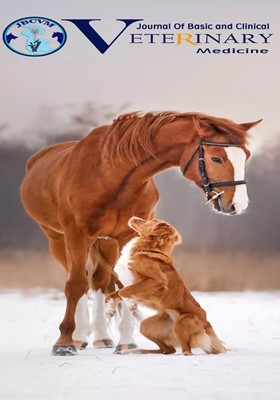Evaluation of antibiotic resistant and molecular identification of Escherichia coli isolates from poultry colibacillosis in Tabriz city during 2020
Subject Areas : Microbiology
1 - Department of Microbiology, Maragheh Branch, Islamic Azad University, Maragheh, Iran
Keywords: poultry, Escherichia coli, Antibiotic resistance, Colibacillosis,
Abstract :
This study conducted to evaluation of antibiotic resistant and molecular identification of Escherichia coli isolates from poultry colibacillosis in Tabriz city during 2020. Forty-six Escherichia coli samples from colibacillosis cases of 10 aviculture in Tabriz city, which had been previously isolated and detected by microbiological and biochemical methods, were identified molecularly with 16s rRNA primers by PCR method. To determine the pattern of antibiotic resistance of isolates, common antibiotics available in the market were used by Kirby-Bauer method. Of 46 Escherichia coli samples tested, 40 isolates (86.9%) were identified as Escherichia coli. All strains of Escherichia coli (100%) were resistant to ampicillin. The most strains were resistant to ceftriaxone (75%), neomycin (70%) and nitrofurantoin (70%). Twelve Escherichia coli strains (30%) were resistant to all of tested antibiotics. It can be concluded that the antibiotic resistance of Escherichia coli isolates to common antimicrobial drugs used in the poultry industry is high. So, implementation of national monitoring programs is strongly needed for antimicrobial resistance and rational use of antibiotics.
[1] Alexander DJ, Senne DA. Newcastle disease, other avian paramyxoviruses, and Pneumovirus infections. Disseases of poultry; 2008.
[2] Lutful Kabir SM. Avian colibacillosis and salmonellosis: a closer look at epidemiology, pathogenesis, diagnosis, control and public health concerns. International Journal of Environmental Research and Public Health. 2010; 7(1):89–114.
[3] Dziva F, Stevens MP. Colibacillosis in poultry: unravelling the molecular basis of virulence of avian pathogenic Escherichia coli in their natural hosts. Avian Pathology. 2008; 37(4):355–66.
[4] Mellata M, Dho-Moulin M, Dozois CM, Curtiss R, Brown PK, Arne P, et al. Role of virulence factors in resistance of avian pathogenic Escherichia coli to serum and in pathogenicity. Infection and Immunity. 2003;71(1): 536–40.
[5] Collingwood C, Kemmett K, Williams N, Wigley P. Is the concept of avian pathogenic Escherichia coli as a single pathotype fundamentally flawed? Frontiers in Veterinary Science. 2014;1: 1–4.
[6] Peighambari SM, Vaillancourt JP, Wilson RA, Gyles CL. Characteristics of Escherichia coli isolates from avian cellulitis. Avian Diseases. 1995;65: 116- 124.
[7] Nolan LK, Barnes HJ, Vaillancourt JP, Abdul-Aziz T, Logue CM. colibacillosis. In: diseases of poultry. 12th edition. (Swayne DE, Mcdougald L, Nolan K, Suarez DL, Nair V). Iowa, USA: John Wiley and Sons, 2013.
[8] Johnson JR, Kuskowski MA, Smith K, O-Bryan TT, Tatini S. Antimicrobial-resistant and extra intestinal pathogenic Escherichia coli in retail foods. Journal of Infectious Diseases. 2005;191: 1040-9.
[9] Chen J, Su Z, Liu Y, Wang S, Dai X, Li Y, et al. Identification and characterization of class 1 integrons among Pseudomonas aeruginosa isolates from patients in Zhenjiang, China. International Journal of Infectious Disease. 2009; 13:717-721.
[10] Goudarzi V, Mirzaee M, Ranjbar R. O-serogrouping of Escherichia coli strains isolated from patients with urinary tract infection by using PCR method. Iranian Journal of Medical Microbiology. 2017; 10(6): 1-8.
[11] CLSI. Performance Standards for Antimicrobial Susceptibility Testing. 27th ed. CLSI supplements M100. Wayne, PA: Clinical and Laboratory Standards Institute, 2017.
[12] Nolan LK, Barnes HJ, Vaillancourt JP, Abdul-Aziz T, Logue CM. Colibacillosis. In: diseases of poultry. 12th edition. (Swayne DE, Mc dougald L, Nolan K, Suarez DL, Nair V). Iowa, USA: John Wiley and Sons, 2013.
[13] Hanson R, Kaneene JB, Padungtod P, Hirokawa K, Zeno C. Prevalence of salmonella and E. coli and their resistance to antimicrobial agents, in farming communities in northern Thailand. Southeast Asian Journal of Tropical Medicine and Public Health. 2002;33: 120-126.
[14] Ozawa M, Harada K, Kojima A, Asi T, Sameshima T. Antimicrobial susceptibilities, serogroups, and molecular characterization of avian pathogenic Escherichia coli isolates in Japan. Avian Diseases. 2008; 52: 392-397.
[15] Azizpour A, Saeidi Namin V. Investigation of antibiotic resistance patterns in Escherichia coli isolated from broiler chickens with colibacillosis to ten antibacterial agents commonly used in the Iranian poultry industry. Journal of Comparative Pathobiology. 2017;14(4): 2345-2352.
[16] Gregova G, Kmetova M, Kmet V, Venglovsky J, Feher A. Antibiotic resistance of Escherichia coli isolated from a poultry slaughterhouse. Annals of Agricultural and Environmental Medicine. 2012;19(1): 75-77.
[17] Mohammadi F. Antibiotic resistance determination in Escherichia coli isolated from poultry samples enffected colibacillosis disease from around Kermanshah farms. Journal of Food Microbiology. 2018; 5(2): 72-78.
[18] Enferad E, Mahdavi S. Antibiotic resistance pattern and frequency of some beta lactamase genes in Klebsiella pneumoniae isolated from raw milk samples in Iran. Journal of the Hellenic Veterinary Medical Society. 2021;71(4), 2455-2462.
[19] Levy S. Reduced antibiotic use in livestock: how Denmark tackled resistance. Environ Health perspect. 2014; 122(6):160-5.
[20] Awad A, Arafat N, Elhadidy M. Genetic elements associated with antimicrobial resistance among avian pathogenic Escherichia coli. Annals of Clinical Microbiology and Antimicrobials. 2016; 15(1):59.
[21] Akond M. Antibiotic resistance of Escherichia coli isolated from poultry and poultry environment of Bangladesh. American Journal of Environmental Sciences. 2009;5(1):47–52.
[22] Snary EL, Kelly LA, Davison HC, Teale CJ, Wooldridge M. Antimicrobial resistance: a microbial risk assessment perspective. Journal of Antimicrobial Chemotherapy, 2004;53(6):906–17.
[23] Castanon JIR. History of the use of antibiotic as growth promoters in European poultry feeds. Poultry Sciences. 2007;86(11):2466–71.
[24] Diarra MS, Malouin F. Antibiotics in Canadian poultry productions and anticipated alternatives. Frontiers in Microbiology. 2014; 5:1–15.
[25] Apata DF. Antibiotic resistance in poultry. International Journal of Poultry Science. 2009;8(4):404–8.

